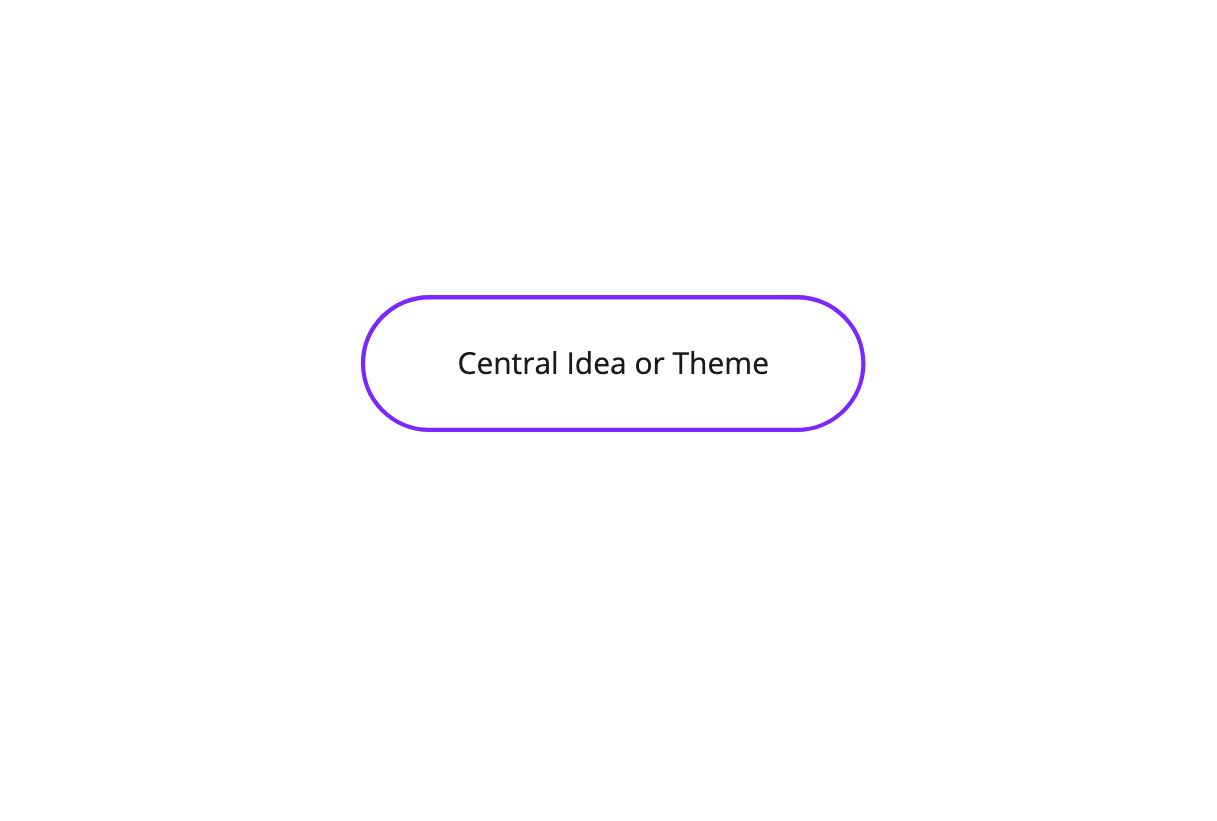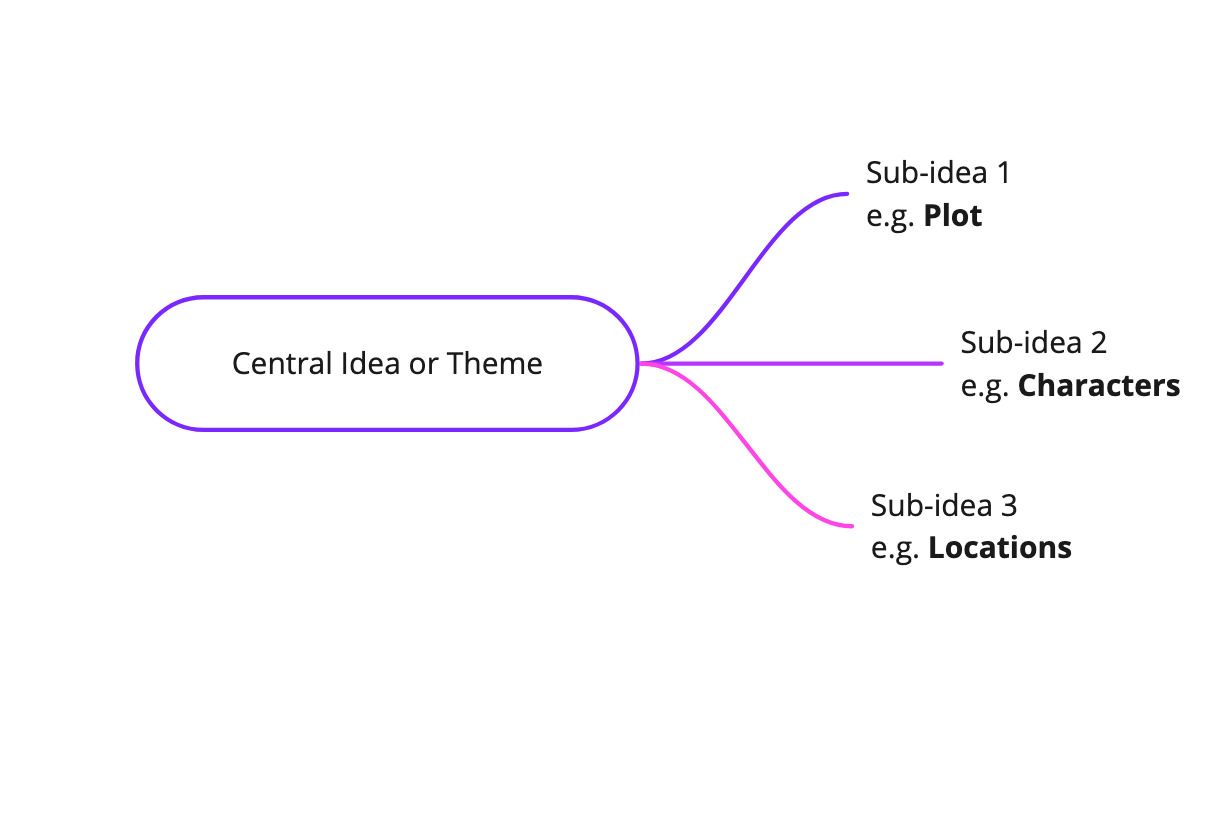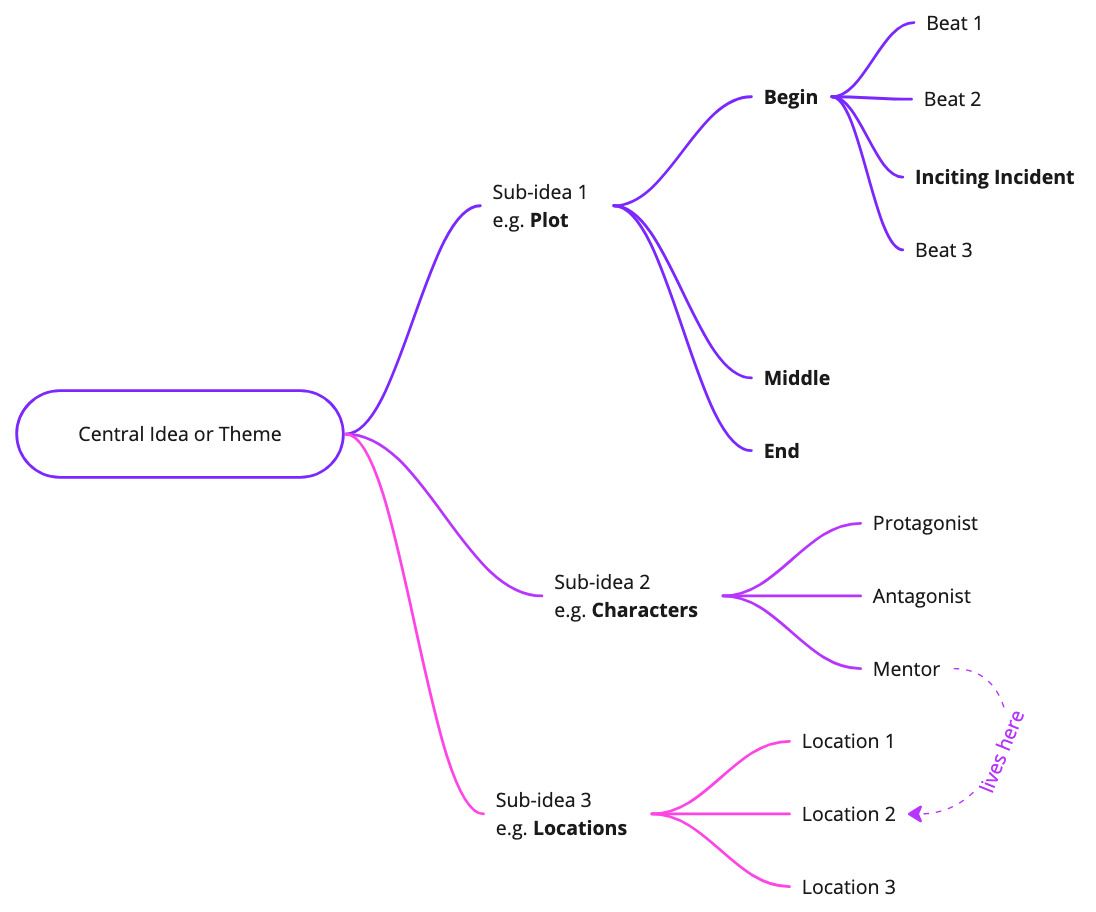A Guide to Outlining Techniques for Writers
The art of outlining extends beyond this rudimentary form and can be a dynamic and creative process in its own right. Here, we'll touch on a selection of outlining techniques, including mind maps, the snowflake method, flashlight outlining, and the use of index cards.

In our recent exploration, we navigated through the wide expanse of our minds using daydreaming as our vessel. We saw how this practice, often perceived as idle or unproductive, can serve as a fertile ground for creative seeds to germinate and bloom. We learned to harness this innate capacity for innovation, and to use it as a springboard to launch into uncharted creative waters.
Today, let's traverse a slightly different path. We're delving into the structured yet versatile world of outlining techniques — an invaluable tool that authors can use to map out their narratives and ensure a coherent and engaging storytelling journey. Outlining can provide a structured scaffold, helping to transform the nebulous whisperings of your creative daydreaming into a flowing narrative.
Many of us might recall from school the basic outlining technique of creating bullet points or numbered lists to arrange ideas in a logical order. However, the art of outlining extends beyond this rudimentary form and can be a dynamic and creative process in its own right. Here, we'll touch on a selection of outlining techniques, including mind maps, the snowflake method, flashlight outlining, and the use of index cards.

Mind Maps
Mind mapping is a dynamic and intuitive outlining technique that is particularly useful for those who think visually and enjoy the freedom of organising ideas in a non-linear way. The result is a network of thoughts that reflects the interconnectedness and flexibility of our thinking process.
Mind maps start with a central theme or concept, similar to the nucleus of a cell, and expand outwards into a myriad of related topics. These topics are visually linked, constituting an intricate network that provides a holistic, bird's-eye view of the information contained within. The power of mind maps lies in their inherent flexibility; the non-linear structure allows new links or nodes to be introduced at any point within the network. This means that there's no strict need for a top-down approach; instead, your creativity can take you in any direction that resonates with your thoughts or ideas.
Furthermore, a mind map embodies your current understanding of a particular narrative. It serves as a compact yet expansive repository for everything you know about your characters, their locations, the plot, and much more. It's more than a tool; it's a dynamic companion that accompanies you throughout your narrative journey. As the story evolves and takes unexpected turns, your Mind Map reflects these changes, reflecting the evolution of your understanding. It's an organic, ever-evolving guide that adapts to the story's twists and turns, facilitating a more profound understanding of the narrative's essence.
Let's have a closer look at these key components of this method.
Central theme or idea

The mind mapping process starts with a central theme or idea. This is the 'root' or 'seed' from which the rest of your story tree will grow. It could be the main conflict of your story, the main character, or the main theme you want to explore.
Choose a starting point that helps you the most. If you don't know the premise of the story yet, maybe start with a character that excites you and let yourself be surprised where your mind mapping might take you!
Branches
From this central theme, you begin to branch out into sub-ideas and related concepts.

These branches can represent characters, subplots, themes or specific scenes. Each branch can then have its own smaller branches, creating a multi-layered, hierarchical structure of ideas.

Visual network
What you end up with is a visual network of interconnected ideas, a holistic picture of your story that is both detailed and comprehensible at a glance. This visual representation can help stimulate further creativity by making it easier to see gaps, make connections and understand the overall structure of your story.

Non-linear organisation, expansion, and connections
One of the defining characteristics of a mind map is its non-linear structure. Unlike traditional top-down outlines, mind maps allow for organic growth in any direction. This means you can freely add, adjust or connect ideas without being constrained by a sequential flow.
For example, let's say you have reached a point where you realise that you need a more comprehensive view of the intricate web of relationships that exist between your characters. You can quickly create a new node, perhaps called 'Character Relationships', at the first level. This node then becomes a springboard from which you can branch out and begin to record the relevant information. Each relationship becomes a separate branch from this new node.

As you can see, mind maps allow for easy expansion and connection of ideas. When a new concept comes to mind, you can simply add another branch or node to your map! Similarly, if you see a new link between existing ideas, you can draw that link directly. This dynamic nature of mind maps facilitates the continuous development and refinement of your narrative.
In essence, mind maps offer a unique blend of visual creativity, flexible structuring and dynamic growth, making them a powerful tool for narrative outlining. They allow you to see the forest and the trees of your story at the same time, keeping track of the big picture while managing individual narrative elements. If you're a visual thinker who appreciates a non-linear, holistic view of your story, mind mapping could be your ideal creative partner.
Snowflake Method
The snowflake method is a systematic and layered approach to outlining developed by Randy Ingermanson. It allows the writer to start small and then gradually build on that foundation, similar to the intricate formation of a snowflake around a nucleus. This method is particularly useful for those who value a more structured, step-by-step process in their storytelling journey.
At the heart of the Snowflake Method is the belief that a novel, like a snowflake, should be meticulously designed. The method begins with a one-sentence summary of the novel that encapsulates the overall idea or theme of the story. This summary serves as a core concept, much like the initial triangle in the snowflake fractal.

From this one-sentence summary, the process expands and delves deeper into the structure of the novel. The next steps involve expanding that sentence to a full paragraph, describing the story setup, major disasters, and ending. This mirrors the development of the snowflake fractal, where additional layers are added to the initial triangle to create a more complex design.

As the process progresses, writers are encouraged to write one-page descriptions of each major character and half-page descriptions of the others. These descriptions should evolve and become more detailed as the story develops, giving the writer the opportunity to fully understand their characters and their roles in the story.
Another vital aspect of the Snowflake Method is the development of an in-depth scene list. This process entails converting the earlier created synopsis into a thorough catalogue of scenes within a spreadsheet, a mind map, or a specialised product like Plottr. This step empowers the writer with a clear visual representation of the narrative structure and provides the flexibility to rearrange the scenes as needed.
Lastly, after having thoroughly outlined the story and its characters, the writer is ready to begin the actual writing of the novel. At this point, the story should flow smoothly, since all the large-scale structures and small-scale details have already been worked out during the previous steps.
In essence, the snowflake method provides a structured and incremental approach to outlining. It's a good choice for those who value detailed planning and systematic development in their storytelling process. It encourages the writer to cycle back to previous steps and make revisions as new insights or ideas emerge.
Flashlight Outlining
At its core, flashlight outlining emphasises exploration and adaptability in writing. Just as a flashlight can only illuminate a limited area of a room, this technique emphasises the value of focusing on immediate plot developments rather than trying to plan an entire narrative at once.
Let's have a look at the key aspects that make up Flashlight Outlining.
Limited outlining in advance
In flashlight outlining, writers sketch only a chapter or two ahead. This provides a sense of direction without committing the writer to a fixed plan. The aim is to create a rough guide, like a compass, that points the way forward, allowing the writer to venture into their narrative with confidence.
Iterative writing
Once the immediate chapters have been outlined, the writer continues to write those chapters. This is a cyclical process – outlining, then writing, and then back to outlining the next chapters. This cyclical approach allows reflection on the unfolding story, which feeds back into the next round of outlining.
Room for discovery
Flashlight outlining allows the writer to embrace a degree of spontaneity. By focusing on a small area of the narrative at a time, they can adapt and change their plans as they go. This mirrors the experience of navigating a dark room with a torch, where the observer can shift the beam in response to new discoveries.
Balancing structure and creativity
The flashlight outline helps maintain a balance between structure and creative freedom. Writers have a blueprint to follow, but are free to modify it as new ideas or perspectives emerge during the writing process. This balance ensures that the story remains coherent, yet dynamic and organic.
Maintain momentum
A key benefit of this method is that it can help maintain narrative momentum. By focusing on the immediate future of the story, writers can often avoid being overwhelmed by the scope of the overall project. This helps to keep the writing process moving at a steady pace.
In summary, flashlight outlining is an approach that values flexibility, immediacy, and balance in the writing process. It's a method suitable for writers who prefer to let their story develop naturally, but still want some structure to guide them. It recognises that writing a story is an act of discovery, almost as much for the writer as for the reader.
Index Cards
Index card outlining is a tactile and interactive method of storytelling. It uses visual stimuli and spatial relationships to facilitate story structuring and revision. Writers who prefer physical interaction and direct manipulation of their story structure will find this method incredibly beneficial.
Let's take a closer look at the specific components of this method.
Visual Representation
When outlining with index cards, each card corresponds to a scene or significant event of the story. This helps divide the story into digestible, manageable pieces. This visual representation makes it easy to understand the plot at a glance and how each scene contributes to the larger narrative.
Physical interaction
Providing a tangible sense of control over the narrative, this method encourages writers to physically interact with their story. The tactile engagement with the cards can stimulate creative thinking and bring new ideas or connections to light.
Flexibility of Order
One of the most beneficial aspects of this method is the ease with which scenes can be rearranged. As each card represents a scene, you can easily move them around, rearrange the order of events or experiment with different narrative structures. This ability to manipulate the narrative flow is a significant advantage for writers when creating or refining their story.
Adding and removing scenes
The index card method also makes it easy to add or remove scenes from the narrative. If a new scene comes to mind, you can create a card for it and place it in the appropriate place. Similarly, if a scene doesn't work or becomes redundant, it can be removed without disrupting the overall structure.
Collaborative potential
This method also has considerable collaborative potential. For example, in a group writing environment, each writer can contribute their own cards, making it easy to integrate and rearrange everyone's ideas. The visibility of the cards encourages discussion, decision-making and collective creativity.
In essence, the index card outlining method offers a dynamic and interactive approach to story planning. It's ideal for writers who appreciate a visual overview of their work and enjoy the flexibility of being able to quickly move, add and remove scenes. Not only is this method practical and efficient, it can also make the process of constructing a narrative more engaging and enjoyable.
Your Choice
These are just a few examples of the myriad outlining techniques available to authors. Each writer is unique, and the technique that works for one may not work for another. It's essential to explore various methods and find what resonates with you and aligns with your creative process.
Remember, outlining isn't about imprisoning your story within a rigid structure, but about creating a flexible framework that guides your narrative. It's about nurturing the seeds of creativity planted during your daydreaming sessions and allowing them to grow and bear fruit in your writing.
We hope this post has offered you some new perspectives and strategies to help navigate your creative journey. Please share your experiences, thoughts, and techniques in the comments section below. We look forward to hearing about how these outlining methods have influenced and shaped your writing. If you find this post helpful, don't hesitate to share it with others!

